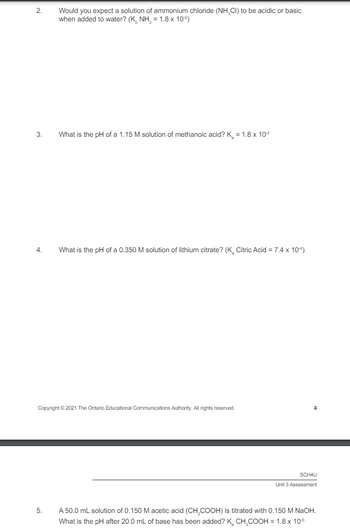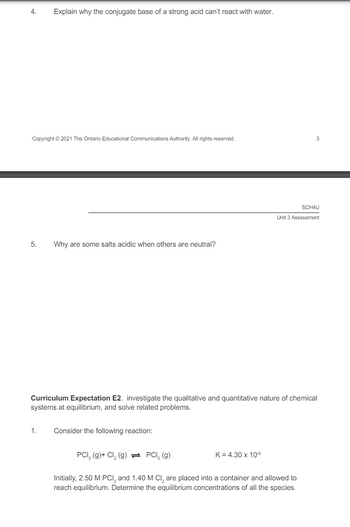
Chemistry
10th Edition
ISBN: 9781305957404
Author: Steven S. Zumdahl, Susan A. Zumdahl, Donald J. DeCoste
Publisher: Cengage Learning
expand_more
expand_more
format_list_bulleted
Question

Transcribed Image Text:2.
Would you expect a solution of ammonium chloride (NHCI) to be acidic or basic
when added to water? (K NH = 1.8 x 10-5)
3.
4.
What is the pH of a 1.15 M solution of methanoic acid? K = 1.8 × 10-4
What is the pH of a 0.350 M solution of lithium citrate? (K. Citric Acid = 7.4 x 10-)
Copyright © 2021 The Ontario Educational Communications Authority. All rights reserved.
5.
SCH4U
Unit 3 Assessment
A 50.0 mL solution of 0.150 M acetic acid (CH COOH) is titrated with 0.150 M NaOH.
What is the pH after 20.0 mL of base has been added? K. CH COOH = 1.8 x 10-5

Transcribed Image Text:4.
Explain why the conjugate base of a strong acid can't react with water.
Copyright © 2021 The Ontario Educational Communications Authority. All rights reserved.
3
5. Why are some salts acidic when others are neutral?
SCH4U
Unit 3 Assessment
Curriculum Expectation E2. investigate the qualitative and quantitative nature of chemical
systems at equilibrium, and solve related problems.
1.
Consider the following reaction:
PCI (g)+ Cl₂ (g)
PCI (g)
K = 4.30 x 10-6
Initially, 2.50 M PCI, and 1.40 M Cl₂ are placed into a container and allowed to
reach equilibrium. Determine the equilibrium concentrations of all the species.
Expert Solution
This question has been solved!
Explore an expertly crafted, step-by-step solution for a thorough understanding of key concepts.
Step by stepSolved in 2 steps

Knowledge Booster
Similar questions
- Tartaric acid is found in many fruits including grapes. Tartaric acid is partly responsible for the dry texture of certain wines. Tartaric acid, H2C4H4O6, is a diprotic acid with the following Ką values: Ka1 = 1.00 x 10-3; Ka2 = 4.60 x 10-5 a. Write the equation for the 1st jonization of tartaric acid. b. Write the equation for the 2nd ionization of tartaric acid. c. Write the Ką expression for the 1st ionization. d. Write the Ką expression for the 2nd ionization. e. What is the equilibrium concentrations of the reactants and products from the 1st ionization of a 0.250M solution of tartaric acid? f. What is the equilibrium concentrations of the reactants and products from the 2nd ionization? g. What is the total [H30+] and the overall pH of the solution of tartaric acid?arrow_forwardTartaric acid is found in many fruits including grapes. Tartaric acid is partly responsible for the dry texture of certain wines. Tartaric acid, H₂C4H406, is a diprotic acid with the following Ka values: Kal = 1.00 x 10-³; K₁2 = 4.60 x 10-5 a. Write the equation for the 1st ionization of tartaric acid. b. Write the equation for the 2nd ionization of tartaric acid. c. Write the Ka expression for the 1st ionization. d. Write the Ka expression for the 2nd ionization. e. What is the equilibrium concentrations of the reactants and products from the 1st ionization of a 0.250M solution of tartaric acid? f. What is the equilibrium concentrations of the reactants and products from the 2nd ionization? g. What is the total [H3O+] and the overall pH of the solution of tartaric acid?arrow_forwardWhat is the pH of 0.80 M Hypobromite acid (HBrO) which is a weak acid? The Ka the wesk acid is 4.5 × 10 -8. Hint: [i]. M [C]. M [E]. M HBrO(aq) 0.80 -X 0.80 - X H+ (aq) + BrO - (aq) 0 0 +X +X Ka (X) (X) / 0.80-X = Hint: Solve for (X) = [H*]E X Then : [H+] at Equilibrium then PH = - Log [H* JE A. PH = 3.2 B. PH = 3.4 C.PH = 3.6 D.PH = 3.7 E.PH = 4.2arrow_forward
- Tartaric acid is found in many fruits including grapes. Tartaric acid is partly responsible for the dry texture of certain wines. Tartaric acid, H₂C4H406, is a diprotic acid with the following Ka values: Ka1 = 1.00 x 10-3; K₁2 = 4.60 x 10-5 a. Write the equation for the 1st ionization of tartaric acid. b. Write the equation for the 2nd ionization of tartaric acid. c. Write the Ka expression for the 1st ionization. d. Write the Ka expression for the 2nd ionization. e. What is the equilibrium concentrations of the reactants and products from the 1st ionization of a 0.250M solution of tartaric acid? f. What is the equilibrium concentrations of the reactants and products from the 2nd ionization? g. What is the total [H3O+] and the overall pH of the solution of tartaric acid?arrow_forward24.arrow_forward3.arrow_forward
- 14.arrow_forwardWhat is the pH for the following aqueous solutions? a. 0250 M Ammonia (Kb = 1.8 X 10-5) b. 0385 M Hydrochloric Acidarrow_forwardit pt Calculate the pH of a solution that has an ammonium chloride concentration of 0.042 M and an ammonia concentration of 0.047 M. pH = Ky=1.8 x 10-arrow_forward
arrow_back_ios
SEE MORE QUESTIONS
arrow_forward_ios
Recommended textbooks for you
 ChemistryChemistryISBN:9781305957404Author:Steven S. Zumdahl, Susan A. Zumdahl, Donald J. DeCostePublisher:Cengage Learning
ChemistryChemistryISBN:9781305957404Author:Steven S. Zumdahl, Susan A. Zumdahl, Donald J. DeCostePublisher:Cengage Learning ChemistryChemistryISBN:9781259911156Author:Raymond Chang Dr., Jason Overby ProfessorPublisher:McGraw-Hill Education
ChemistryChemistryISBN:9781259911156Author:Raymond Chang Dr., Jason Overby ProfessorPublisher:McGraw-Hill Education Principles of Instrumental AnalysisChemistryISBN:9781305577213Author:Douglas A. Skoog, F. James Holler, Stanley R. CrouchPublisher:Cengage Learning
Principles of Instrumental AnalysisChemistryISBN:9781305577213Author:Douglas A. Skoog, F. James Holler, Stanley R. CrouchPublisher:Cengage Learning Organic ChemistryChemistryISBN:9780078021558Author:Janice Gorzynski Smith Dr.Publisher:McGraw-Hill Education
Organic ChemistryChemistryISBN:9780078021558Author:Janice Gorzynski Smith Dr.Publisher:McGraw-Hill Education Chemistry: Principles and ReactionsChemistryISBN:9781305079373Author:William L. Masterton, Cecile N. HurleyPublisher:Cengage Learning
Chemistry: Principles and ReactionsChemistryISBN:9781305079373Author:William L. Masterton, Cecile N. HurleyPublisher:Cengage Learning Elementary Principles of Chemical Processes, Bind...ChemistryISBN:9781118431221Author:Richard M. Felder, Ronald W. Rousseau, Lisa G. BullardPublisher:WILEY
Elementary Principles of Chemical Processes, Bind...ChemistryISBN:9781118431221Author:Richard M. Felder, Ronald W. Rousseau, Lisa G. BullardPublisher:WILEY

Chemistry
Chemistry
ISBN:9781305957404
Author:Steven S. Zumdahl, Susan A. Zumdahl, Donald J. DeCoste
Publisher:Cengage Learning

Chemistry
Chemistry
ISBN:9781259911156
Author:Raymond Chang Dr., Jason Overby Professor
Publisher:McGraw-Hill Education

Principles of Instrumental Analysis
Chemistry
ISBN:9781305577213
Author:Douglas A. Skoog, F. James Holler, Stanley R. Crouch
Publisher:Cengage Learning

Organic Chemistry
Chemistry
ISBN:9780078021558
Author:Janice Gorzynski Smith Dr.
Publisher:McGraw-Hill Education

Chemistry: Principles and Reactions
Chemistry
ISBN:9781305079373
Author:William L. Masterton, Cecile N. Hurley
Publisher:Cengage Learning

Elementary Principles of Chemical Processes, Bind...
Chemistry
ISBN:9781118431221
Author:Richard M. Felder, Ronald W. Rousseau, Lisa G. Bullard
Publisher:WILEY